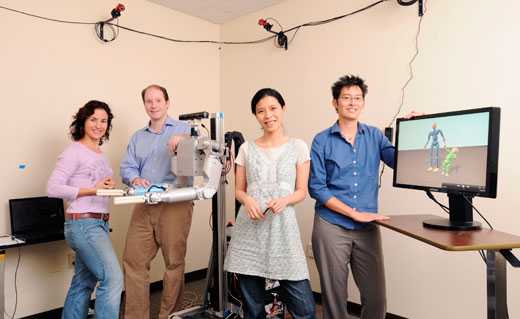Research
September 30, 2011
Robots as rehab assistants?
NSF Emerging Frontiers award supports development of human-machine cooperation

The robot developed through the project could enhance, assist and improve motor skills in humans with varying motor capabilities and deficits.
By Holly Korschun
Scientists at Emory and the Georgia Institute of Technology will develop a "therapeutic robot" to help rehabilitate and improve motor skills in people with mobility problems.
The National Science Foundation (NSF) has awarded the scientists a $2 million research grant over four years through its Division of Emerging Frontiers in Research and Innovation. The project is called "Partnered Rehabilitative Movement: Cooperative Human-robot Interactions for Motor Assistance, Learning and Communication."
"Our vision is to develop robots that will interact with humans as both assistants and movement therapists," explains principal investigator Lena Ting, associate professor in the Coulter Department of Biomedical Engineering at Georgia Tech and Emory. "We expect our project to have a long-term impact on quality of life of individuals with movement difficulties, such as those caused by Parkinson's disease, stroke, and injury, by improving fitness, motor skills and social engagement."
The robot developed through the project could enhance, assist and improve motor skills in humans with varying motor capabilities and deficits.
Other applications of the technologies and theories developed could include the design of prosthetic devices or sports robots that entertain and improve fitness.
The researchers also believe their work will advance understanding of how the brain controls movement and other functions.
Madeleine Hackney, assistant professor of medicine (geriatrics) in the School of Medicine is co-principal investigator of the project. Co-principal investigators at Georgia Tech are biomedical engineering assistant professor Charlie Kemp and assistant professor of interactive computer science Karen Liu.
The scientists will begin their work by studying how humans use their muscles to walk, balance and generate force signals with the hands for guidance when moving in cooperation with another person.
They will study "rehabilitative partnered dance," which has been specifically adapted to help improve gait and balance in individuals with motor impairments. The partnered dance is based on tactile and motor cooperation between two individuals.
The goal is to then program a humanoid rehabilitation robot to perform a "partnered box step."
Over the course of the project, the team will test their models of human sensorimotor coordination, cooperation and communication by demonstrating the robot's ability to participate in the box step as a leader or follower and adapt its movements to the motor skill level of a human partner.
